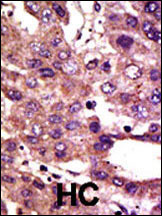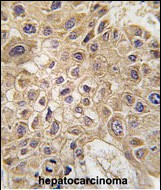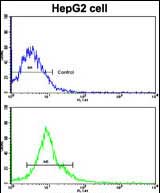AMFR Antibody (C-term)
Purified Rabbit Polyclonal Antibody (Pab)
- 产品详情
- 文献引用 : 2
- 实验流程
- 背景知识
Application
| WB, IHC-P, FC, E |
|---|---|
| Primary Accession | Q9UKV5 |
| Other Accession | P26442 |
| Reactivity | Human |
| Host | Rabbit |
| Clonality | Polyclonal |
| Isotype | Rabbit IgG |
| Calculated MW | 72996 Da |
| Antigen Region | 571-601 aa |
| Gene ID | 267 |
|---|---|
| Other Names | E3 ubiquitin-protein ligase AMFR, 632-, Autocrine motility factor receptor, AMF receptor, RING finger protein 45, gp78, AMFR, RNF45 |
| Target/Specificity | This AMFR antibody is generated from rabbits immunized with a KLH conjugated synthetic peptide between 571-601 amino acids of human AMFR. |
| Dilution | WB~~1:1000 IHC-P~~1:100~500 FC~~1:10~50 E~~Use at an assay dependent concentration. |
| Format | Purified polyclonal antibody supplied in PBS with 0.09% (W/V) sodium azide. This antibody is prepared by Saturated Ammonium Sulfate (SAS) precipitation followed by dialysis against PBS. |
| Storage | Maintain refrigerated at 2-8°C for up to 2 weeks. For long term storage store at -20°C in small aliquots to prevent freeze-thaw cycles. |
| Precautions | AMFR Antibody (C-term) is for research use only and not for use in diagnostic or therapeutic procedures. |
| Name | AMFR {ECO:0000303|PubMed:10456327, ECO:0000312|HGNC:HGNC:463} |
|---|---|
| Function | E3 ubiquitin-protein ligase that mediates the polyubiquitination of lysine and cysteine residues on target proteins, such as CD3D, CYP3A4, CFTR, INSIG1, SOAT2/ACAT2 and APOB for proteasomal degradation (PubMed:10456327, PubMed:11724934, PubMed:12670940, PubMed:19103148, PubMed:24424410, PubMed:28604676). Component of a VCP/p97-AMFR/gp78 complex that participates in the final step of endoplasmic reticulum-associated degradation (ERAD) (PubMed:10456327, PubMed:11724934, PubMed:19103148, PubMed:24424410). The VCP/p97-AMFR/gp78 complex is involved in the sterol-accelerated ERAD degradation of HMGCR through binding to the HMGCR-INSIG1 complex at the ER membrane (PubMed:16168377, PubMed:22143767). In addition, interaction of AMFR with AUP1 facilitates interaction of AMFR with ubiquitin-conjugating enzyme UBE2G2 and ubiquitin ligase RNF139, leading to sterol-induced HMGCR ubiquitination (PubMed:23223569). The ubiquitinated HMGCR is then released from the ER into the cytosol for subsequent destruction (PubMed:16168377, PubMed:22143767, PubMed:23223569). In addition to ubiquitination on lysine residues, catalyzes ubiquitination on cysteine residues: together with INSIG1, mediates polyubiquitination of SOAT2/ACAT2 at 'Cys-277', leading to its degradation when the lipid levels are low (PubMed:28604676). Catalyzes ubiquitination and subsequent degradation of INSIG1 when cells are depleted of sterols (PubMed:17043353). Mediates polyubiquitination of INSIG2 at 'Cys-215' in some tissues, leading to its degradation (PubMed:31953408). Also regulates ERAD through the ubiquitination of UBL4A a component of the BAG6/BAT3 complex (PubMed:21636303). Also acts as a scaffold protein to assemble a complex that couples ubiquitination, retranslocation and deglycosylation (PubMed:21636303). Mediates tumor invasion and metastasis as a receptor for the GPI/autocrine motility factor (PubMed:10456327). In association with LMBR1L and UBAC2, negatively regulates the canonical Wnt signaling pathway in the lymphocytes by promoting the ubiquitin-mediated degradation of CTNNB1 and Wnt receptors FZD6 and LRP6 (PubMed:31073040). Regulates NF-kappa-B and MAPK signaling pathways by mediating 'Lys-27'-linked polyubiquitination of TAB3 and promoting subsequent TAK1/MAP3K7 activation (PubMed:36593296). Required for proper lipid homeostasis (PubMed:37119330). |
| Cellular Location | Endoplasmic reticulum membrane; Multi-pass membrane protein. Note=Palmitoylation promotes localization to the peripheral endoplasmic reticulum |
| Tissue Location | Widely expressed.. |
For Research Use Only. Not For Use In Diagnostic Procedures.

Provided below are standard protocols that you may find useful for product applications.
BACKGROUND
Autocrine motility factor (AMF) is a protein secreted by tumor cells that stimulates tumor motility. The gene for AMFR encodes a 323-amino acid polypeptide that has a single transmembrane domain and several putative glycosylation sites. The protein sequence has some homology to human tumor protein p53.
REFERENCES
Huang, B., et al., Biochem. Biophys. Res. Commun. 212(3):727-742 (1995).
Watanabe, H., et al., J. Biol. Chem. 266(20):13442-13448 (1991).
终于等到您。ABCEPTA(百远生物)抗体产品。
点击下方“我要评价 ”按钮提交您的反馈信息,您的反馈和评价是我们最宝贵的财富之一,
我们将在1-3个工作日内处理您的反馈信息。
如有疑问,联系:0512-88856768 tech-china@abcepta.com.






















 癌症的基本特征包括细胞增殖、血管生成、迁移、凋亡逃避机制和细胞永生等。找到癌症发生过程中这些通路的关键标记物和对应的抗体用于检测至关重要。
癌症的基本特征包括细胞增殖、血管生成、迁移、凋亡逃避机制和细胞永生等。找到癌症发生过程中这些通路的关键标记物和对应的抗体用于检测至关重要。 为您推荐一个泛素化位点预测神器——泛素化分析工具,可以为您的蛋白的泛素化位点作出预测和评分。
为您推荐一个泛素化位点预测神器——泛素化分析工具,可以为您的蛋白的泛素化位点作出预测和评分。 细胞自噬受体图形绘图工具为你的蛋白的细胞受体结合位点作出预测和评分,识别结合到自噬通路中的蛋白是非常重要的,便于让我们理解自噬在正常生理、病理过程中的作用,如发育、细胞分化、神经退化性疾病、压力条件下、感染和癌症。
细胞自噬受体图形绘图工具为你的蛋白的细胞受体结合位点作出预测和评分,识别结合到自噬通路中的蛋白是非常重要的,便于让我们理解自噬在正常生理、病理过程中的作用,如发育、细胞分化、神经退化性疾病、压力条件下、感染和癌症。









